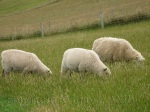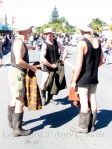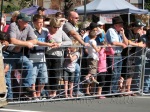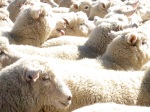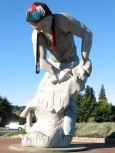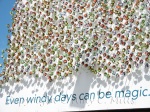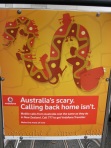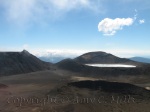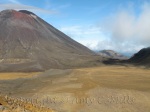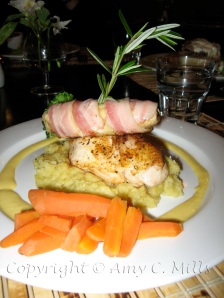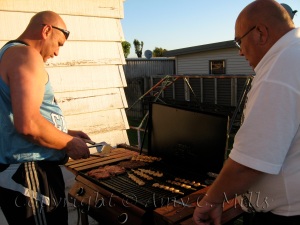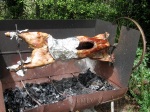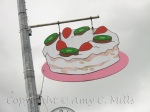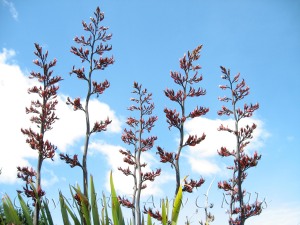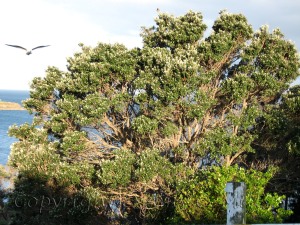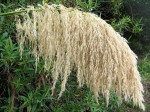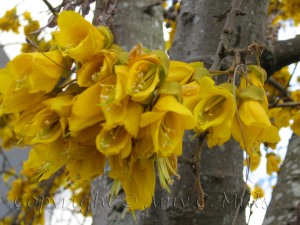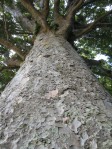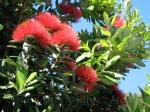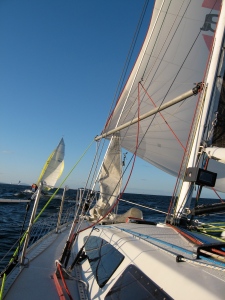Let’s just get it out of the way. Yes, there are 40 million sheep in New Zealand. And only 4 million people. That works out to 10 sheep per person. When you get your permanent residency, they send you a letter telling you that you can now call yourself a Kiwi and answer most questions with an emphatic “mmm.” And the shepherd shows up the next day with your sheep. You better have a big backyard all worked out, or those woolly quadrupeds are going to get mighty hungry.
Actually, I have no idea how there are so many sheep here. I do know how they transport them from island to island. They go on the Cook Strait ferry, of course! Riding on a triple or quadruple-decker truck. It’s quite a sight to look down on the lower deck and see a rectangle of woolly backs peeking out the top of an 18-wheeler. If you’re on the cheap ferry (because you’re taking a car and it’s bloody expensive), you want to sit in the front of the boat, so you don’t have to smell the sheep or listen to their sheepdog telling them endlessly to stop baaing and SETTLE DOWN!
It’s possible that I first became fascinated with shepherding when I was Little Bo Peep for Halloween in the third grade. Or, possibly, when I read about classical Paris herding sheep on the hills above Troy. Perhaps, it started when I read the melancholy Romanian ballad Miorița (The Little Ewe) in college. Or when I imagined some bored shepherdess inventing flutes and bagpipes in the mountains of Scotland or Bulgaria. I suspect that classic Hungarian folk dance ensemble piece where a boy and a girl cover their heads with a huge shepherd’s cloak to smooch might have something to do with it, too. And then, I keep moving to countries that are just chock-a-block with the walking woolly sweaters.
It’s not the sheep, you see. I’m interested in the lives that people build around sheep herding. And the music they create. And the clothes they wear. While everyone else is taking photos of the sheep, I’m trying to get that shot of the bemused Turkish or Romanian shepherd.
Not that the sheep aren’t nice to look at, too. I think those of us who’ve never had to actually take care of them – and who grew up with perfectly white sheep in our picture books – can’t help but coo over the things. Every New Zealander can tell you about being stuck behind foreign drivers trying to get that perfect picture of Kiwi’s wool and mutton industry on the hoof. (It doesn’t help that most of the roads are one-lane each way.) I’ve taken my share of those pics, too.
But I go beyond that. In Romania, I made a point of going to the Măsuratul Laptelui (or Measuring of the Milk) event in the Banat region. In the early spring, the sheep owners get together with the shepherds before they take the combined flocks off to the mountains for the summer. The sheep are milked and the milk is measured, to establish what proportion of the whole comes from each farmer’s herd. That way, the shepherds and the owners can agree on how much sheep cheese should go to each household at the end of the season. I tried my hands at milking and chatted with the shepherds and owners. And I got to try fresh sheep cheese. Yum! The whole time I was milking, I was convinced someone was going to squirt me as a joke. But that would have been a waste of the milk, eh?
I’ve even had a shepherd ask me to marry him. It’s pretty surreal to be sitting in a Romanian train station at midnight, talking to two nice but grubby guys in their funny Sibiu shepherd hats. Especially when one of them tells you that you look young and sturdy and ought to marry him because his wife died and he could use someone like you to help out. I have to give the man credit. He was the only person in Eastern Europe who asked me to marry him that didn’t just want a visa to the USA. I liked that he inhabited his own world so comfortably. I winked and told him I’d think about it.
In New Zealand, I knew I had to go to see a sheep shearing competition as soon as I read about the Golden Shears in Witi Ihimaera’s novel Bulibasha. His descriptions of the excitement in the shearing shed and the grace of the shearers enchanted me. In one passage, he describes the wool handlers throwing the fleeces so that they unfurl in the air and float down perfectly onto the wool tables. This I had to see!
I missed the Golden Shears in Masterton in March, but I managed to make it to the New Zealand Shearing Championships a few weekends ago. The event takes place every April in Te Kuiti, the self-proclaimed Shearing Capital of the World. I suppose this is fair, since local son David Fagan is the only five-time world champion shearer.
On the last day of the New Zealand Shearing Championships, the small inland town celebrates its sheep-ishness with the Great New Zealand Muster. The highpoint of the daytime festival is when several thousand sheep run down the main street of Te Kuiti. Having heard of the fantastic Trailing of the Sheep in Idaho, I wanted to see the Kiwi version.
We got to town several hours before sheep o’clock, so we wandered around the local festival. I didn’t know whether to expect a huge undertaking or a small-town celebration. It was more of the latter, but that fit Te Kuiti perfectly. We did our best to ignore the endless, repetitive bleating of the MCs being broadcast up and down the street. (Why does every small NZ event have some guy blathering ad nauseum?) Besides, the street entertainers were more interesting. A threesome clad in traditional rural Kiwi costume – gumboots, black singlets, floppy hats and short shorts – performed humorous boot-slapping and sheep-wrangling dances. The Te Kuiti & Districts Highland Pipe Band, also in gumboots, parted the crowds on their way down Rora Street. Further down the way, Chuck said, “Hey, look the Peruvian panpipe guys have gone Native American,” and I turned around to see a duo dressed in Plains Indian regalia and playing floaty flute music. I still don’t know what that was about or where the were from. (See the video and let me know what’s going on!)
Meanwhile, the fire service demonstrated what happens when you leave your cooking oil heating on the stove unattended. There’s a whole TV campaign about this right now. I guess folks aren’t attending to their fry-ups as they should. Chuck drooled over the ‘cheap as’ sausage sizzle, in vain hopes of a spicy brat in Kiwiland. I browsed the crafts stalls, wondering why every small NZ festival has someone selling ceramic koru (fern fronds). Another vendor sold carvings made out of real fern tree trunks, which I figure is New Zealand’s version of chainsaw sculpture.
The local merchants had their wares out onto the sidewalks, offering sales, and their windows were bedecked with sheep scenarios. The best part was the signs. Every shop “changed” its name for the day by hanging up plywood signs with sheep puns. The Four Square grocery became “Footrot Dairy,” a hairdresser was “The Clip and Dip Shed”, Blokes clothing shop was “Studs ‘n’ Ewe.” My favorite was the computer store: Rams N Roms 4 Ewe.
And then came the sheep. Except, they weren’t sure they wanted to. With several thousand bipeds fenced in (out?) on both sides of the street, the herd started tentatively down Rora Street. The few at the front must have realized, “Aaa! I don’t want to be in the front! I want to follow someone else! Where am I going?” These are sheep, after all. Someone must have gotten some dogs behind them, as they finally rallied and ran down towards us. I found the movement of the galloping herd mesmerizing. Like a woolly wave crashing towards us.
And then, they circled. And circled. And circled. And jumped up on each other’s backs to see what was going on in this hot, woolly crowd. They were penned in about halfway down the street, you see. This was a great opportunity for the MCs to blather more and for us to watch some sheep shearing. They used a fascinating hand-crank contraption to run the shear blades, which gave the audience a chance to see their national Lotto guy trying to go fast enough for the champion shearer on the stand.
Finally, the sheep were herded through a narrow opening and up over a ramp, so they could be counted. There was a prize for guessing the right number, so most people were frozen in frenzied counting. (There were 1079.) We skipped that and ran around to see the sheep come scrambling down the ramp into a leaping, gamboling, scampering single-file line running down the street. It was so joyful that I wanted to join them!
After a singularly uninspired dinner, we wandered down a few blocks to see the finals of the New Zealand Shearing Championships. The Waitomo Community Cultural Arts Center stage was transformed into a shearing shed, with six stands for competitors. There was something both corny and wonderful about the event. On the one hand, things started off with a fog machine and flashing concert lighting, accented by big announcer voices and that corporate-sounding music that absolutely must have squealing guitars and a driving beat. One of the MCs was a local celebrity whom I’d never heard of – musician and weekly Lotto presenter, Russell Harrison. To be fair, Russell was funny and clever and a good singer. He was paired awkwardly with a local presenter sporting a bowtie and tossing off occasional awkward jokes. The show was interspersed with musical interludes that were nicely presented but drew heavily on an oldies repertoire that has long since become haggard. (Especially if you are frustrated that most NZ radio hasn’t quite made it out of the 1980s. Sigh.)
On the other hand, the shearing and wool-handling competitions themselves were intense and riveting. And the play-by-play announcers were mesmerizing. And funny. They referred to one of the shearers as the Pocket Rocket. I think they were referring to the fact that he was a slight man.
Each match starts with six shearers lunging through the gate for a sheep, dragging it backwards and wedging it between his legs. Yank, and the hand-piece starts. Blink, and the belly and left flank are wool-less. The shearer leans the head back gently and clears a path under the neck and over the forehead. Wool keeps dropping in a steady stream, as the sheep is rolled over and around. The hand-piece flies up over the last flank and the naked ungulate slips through the shearer’s legs back to safety. That’s a 41-second buzz cut for you.
The shearers veritably danced with the bewildered quadrupeds. I imagine the sheep just don’t know what hit them. On the other hand, it’s probably ideal to be sheared by these world-class workers, as it’s over fast and you’re less likely to be nicked. During the event, I kept having to remind myself that these (mostly) guys know how to do this so well because this is what they do day in and day out when it’s shearing season. Take 40 million sheep and multiply by 41 seconds each…
The evening consisted of six events, including the Circuit Final, the Open Woolhandling Final and the overall Shearing Final. All the competitors were from New Zealand, except the two-against-two contest between Wales and New Zealand teams. (New Zealand won.) In everything except the wool handling there was at least one member of the extended Fagan family. The announcers played the crowd, encouraging them to get loud and proud for these local Te Kuiti favorites.
In some ways, my favorite event was the wool handling final. All the competitors except one were women, and we got to see how these athletic ladies collected and sorted the wool as it dropped from the fleece. This work is key to getting the best money for your wool, as the “fleecos” have to separate the different grades that come from the same sheep. It turns out that the merino wool sticks together best, so that the wool handlers could gather the whole fleece up in their arms and run off with it. We saw this during the circuit final, when competitors shear five merinos, five ewes, and five lambs. The wool handling final was only Romneys, though, so I didn’t get to see that wonderful fleece toss I’d been imagining. But they did end the contest with shaking the huge piles of wool to mix the long and short hairs. There’s something about that cascade of curly locks flying around that’s strangely satisfying.
And indeed, local son David Fagan won the North Island Shearer of the Year again for the 17th time, at the age of 48. He’s off to Wales for the Golden Shears and Wool Handling championships in July. Anyone know someone I can stay with in Llanelwedd?
See video of the Muster at: Sheep! – Running of the Sheep by jocuteca.
See video of the NZ Shears: at Sheep! – NZ Shears by jocuteca.
More still photos from both events at: NZ – Sheep! at Te Kuiti Muster by jocuteca.






